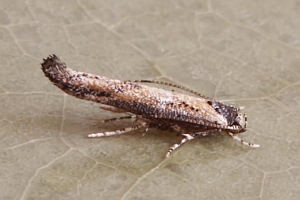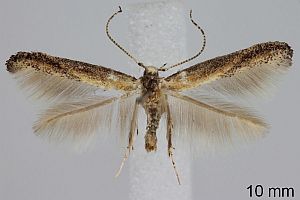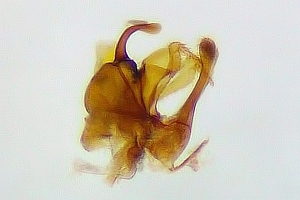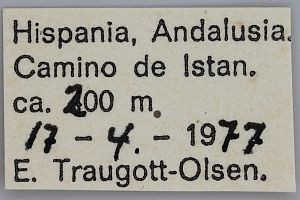

 +9Kontinente:EUAF
+9Kontinente:EUAF1. Lebendfotos
1.1. Falter
2. Diagnose
2.1. Geschlecht nicht bestimmt
2.2. Genitalien
2.2.1. Männchen
4. Weitere Informationen
4.1. Taxonomie
Nach Nel (2000) stellte Sinev (1999) die von Nel & Brusseaux (1997) von Korsika beschriebene Coccidiphila rungsella Nel & Brusseaux, 1997 ohne Begründung in die Synonymie von C. danilevskyi. Dem widersprach Nel (2000): Nach ihm weichen die männlichen Genitalien der Typenserie von Korsika deutlich von echten C. danilevskyi ab, die er erstmals auch aus Frankreich meldete: "La figure 2 représente les genitalia d'un authentique C. danilevskyi Sinev, 1997 provenant des Pyrénées-Orientales, Arboussols, 9. V. 1993, gén. JN 3104 (J. Nel leg.) qui est donc une espèce nouvelle pour la France. Ses genitalia sont tout à fait conformes à ceux de l'holotype de C. danilevskyi provenant d'Espagne, Andalousie (fig. 3, d'après Sinev, 1997)." Koster & Sinev (2003: 134-135) stellen C. rungsella aber in die Synonymie von Coccidiphila ledereriella und kommentieren: "There are no reliable differences between lederiella and rungsella in both external characters and genitalia. The drawings of the paratype and holotype of rungsella in Nel & Brusseaux (1997) and Nel (2000) clearly shows the typical male genitalia of lederiella."
Koster & Sinev (2003: 135) führen C. danilevskyi auf Artebene, halten aber auch eine Betrachtung als Unterart von Coccidiphila ledereriella für möglich.
Falck & Karsholt (2019: 333) gehen auf Probleme mit der Bestimmung von Arten der Gattung Coccidiphila auf den Kanarischen Inseln ein und verfassen den Kommentar: "The status of C. ledereriella and C. danilevskyi as distinct species is unclear Koster & Sinev (2003: 135), and according to Koster (in litt.) they are most likely synonyms. Awaiting further research, especially based on studied of the DNA of the involved species, we refrain from establishing new synonyms here."
4.2. Faunistik
Locus typicus nach Sinev (1997): „Hispania, Andalusia, Camino de Istan., ca. 400 m“ [Holotypus].
Die recht große Paratypen-Serie stammt aus Fundorten in Spanien, Marokko, Mauretanien und Tunesien. Nel (2000) führt die Art aus den östlichen Pyrenäen von Frankreich an.
Timossi (2020: 12) meldet den Erstnachweis für Italien: 1 Weibchen im Riserva Naturale Regionale Integrale “Bosco Nordio” in Venetien.
(Autor: Erwin Rennwald)
4.3. Literatur
- Falck, P. & O. Karsholt (2019): New data on Praydidae, Oecophoridae, Stathmopodidae, Scythrididae and Cosmopterigidae from the Canary Islands, Spain (Insecta: Lepidoptera). — SHILAP Revista de Lepidopterología 47 (186): 325-340. [PDF auf redalyc.org]
- Fernández, J. (1998): Noticia de nuevos táxones para la ciencia en el ámbito íbero-balear y macaronésico. — Graellsia 54: 143-168. [PDF auf www.fauna-iberica.mncn.csic.es].
- Koster, S.J.C. & S.Yu. Sinev (2003): Momphidae, Batrachedridae, Stathmopodidae, Agonoxenidae, Cosmopterigidae, Chrysopeleiidae. — In: Huemer, P., Karsholt, O. & L. Lyneborg [ed.]: Microlepidoptera of Europe 5: 1-387. Stenstrup (Apollo Books).
- Nel, J. (2000): A propos des Coccidiphila Danilevsky, 1950, de France; C. rungsella Nel & Brusseaux, 1997, bona species, stat. restauré (Lep. Cosmopterygidae). — Bulletin de la Société entomologique de France 105 (1): 22. [PDF auf persee.fr]
- Nel, J. & G. Brusseaux (1997): Coccidiphila rungsella n. sp. (Momphidae). Notes sur la répartition de quelques Gelechioidea (Lepidoptera). — Alexanor, 19 (8): 455-459. [Sekundärzitat]
- Erstbeschreibung: Синёв, С. Ю. (1997): Краткий обзор рода Coccidiphila Dan. (Lepidoptera, Cosmopterigidae) с описанием нового вуда из западного средиземноморья [A brief review of the genus Coccidiphila Dan. (Lepidoptera, Cosmopterigidae) with description of a new species from west mediterranean]. — Энтомологическое обозрение 76 (1): 203-209.
- Sinev, S. Yu. (1999): Notes on Synonymy of Narrow-winged Moths (Lepidoptera: Agonoxenidae, Cosmopterigidae, Momphidae) of the Palaearctic. — Entomological Review 79 (1): 30-39. [Sekundärzitat nach Inhaltsverzeichnis auf pleiades.online]
- Timossi, G. (2020): Contributo alla conoscenza dei lepidotteri della Riserva Naturale Regionale Integrale “Bosco Nordio”. - Lavori – Società Veneziana di Scienze Naturali, 45: 5-29. [zum PDF-Download auf researchgate.net]














